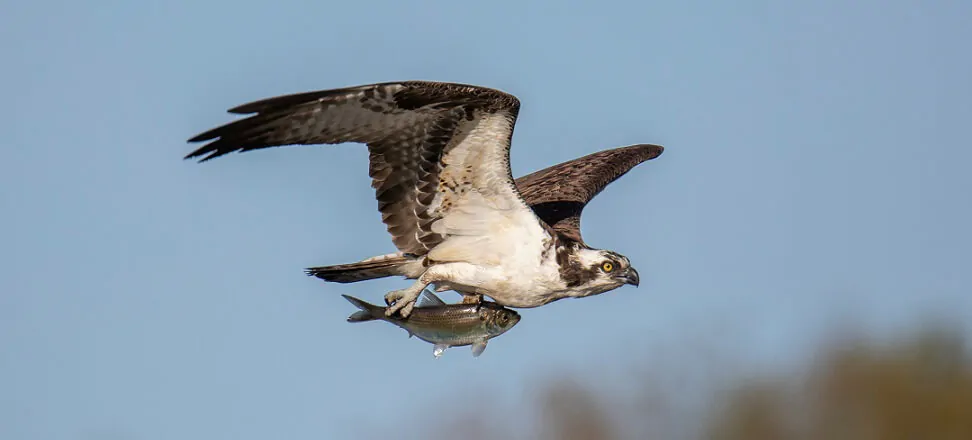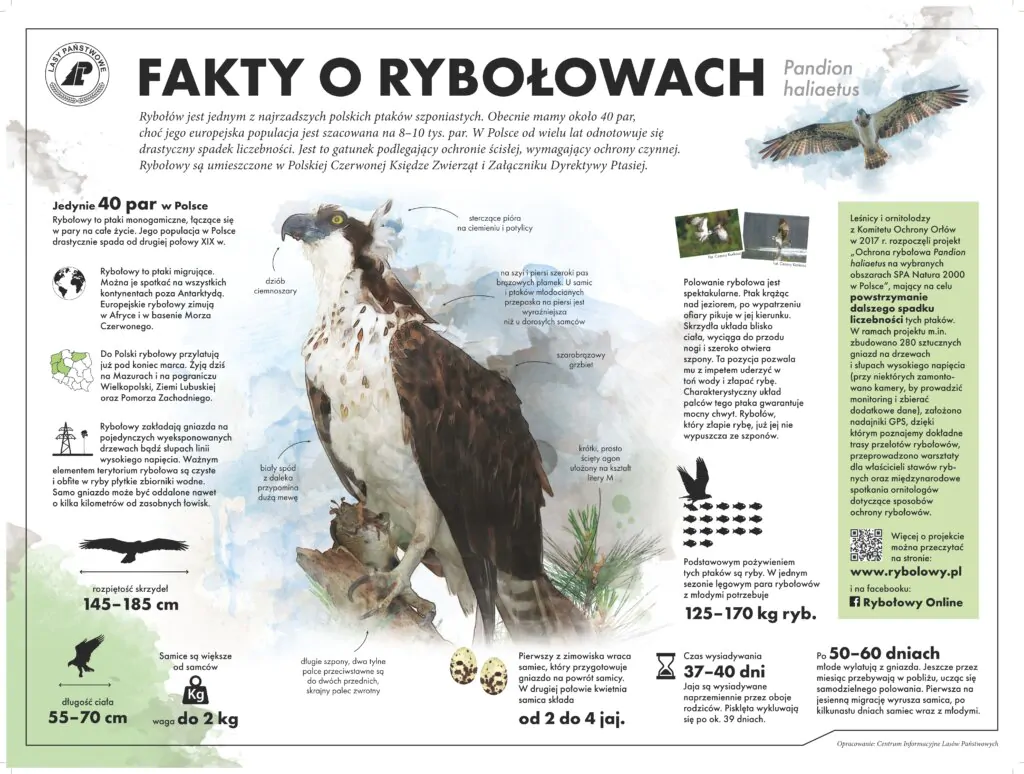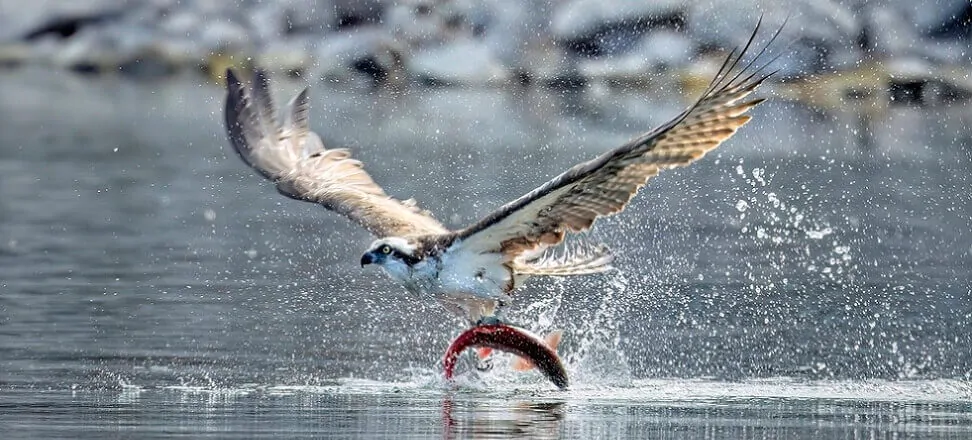Issue 14/2024, Issue topic
Osprey – a huge bird, rarer than lynx in Polish forests
The osprey, a majestic bird of prey perfectly adapted to life on the water, became the hero of our holiday interview. A characteristic feature of these rare birds is the construction of nests on tall poles or single trees, necessarily near bodies of water, which ensures their safety from predators and facilitates access to their main food source – fish. Dominika Nadolna of the Lipka Forest District tells about her passion for observing and protecting these unusual birds.
Agnieszka Hobot: What inspired you to deal with the osprey population?
Dominika Nadolna: I have been working in the Lipka Forest District for 15 years, and I have been dealing with ospreys for 10. Previously, I worked in silviculture, then forest protection, including in the field, and in parallel in social media. At that time, the opportunity to observe the nest of white-tailed eagles, from which the transmission could be followed in real time on the Internet, thanks to the Kutno Forest District, was quite popular. This action inspired the initiator of osprey care. Such a course of action was the idea of Mr. Tomasz Konieczny, who at the time served as deputy forestry chief. He is very passionate about birds of prey, and ospreys have always been close to his heart.
Our forestry division also cooperates with prof. Tadeusz Mizera of the Poznań University of Life Sciences, a member of the Committee for the Protection of Eagles, among other things, in establishing protective zones around nests. The joint activities date back to the student days of Mr. Tomasz Konieczny and forestry supervisor Janusz Grabowski, when the idea of inviting ospreys to the vicinity of our forestry district first appeared. There is not only the Grudnia Lagoon, but also many other lakes, which creates ideal nesting conditions for these rare raptors in Poland. Especially since the birds were already present in the region of the Pila forests – southwest of the forest district.
To encourage ospreys to stay in the area, we built a special nest for them. The first platform was established in 1998, and a year later these beautiful birds began to appear in our forest district, where they can be admired for almost 30 years. Their history includes many different events – for better and worse. In the past, the nest of our ospreys was blown away by the wind, another time it was occupied by white-tailed eagles, which prompted them to build on their own in other places – on the highest voltage poles.
And that’s when the idea of online streaming was born. With the approval of the Polish Power Grid, we prepared and installed platforms that do not threaten the flow of electricity and are safe for ospreys. The birds have chosen a transverse beam from which they have a very expansive view of the surrounding area and an easy flight to the nest. Ospreys need space to look out for predators, so they often choose single trees, for example, in logged areas, with flat crowns that provide a wide horizon. This gives them easy access to the nest, but also a view of the surrounding area – then they feel safer.
Exactly such conditions are provided by their nest on the highest voltage pole. There we installed a camera powered by electricity from solar panels. It was necessary to organize technical facilities, without which it would be impossible to make the nest broadcasts available on the Internet. Preparing everything was not an easy task. We had to get permission from the RDEP to enter the zone (to install all the equipment) and monitor the nest, as ospreys are a protected species.
The bureaucratic obstacles were quite serious, but we didn’t give up, and as a result we were able to launch the project. At the same time, YouTube broadcasts began and an Osprey online profile was launched. Initially, it was run by staff from the State Forestry Information Center based in Warsaw, so it was necessarily difficult for them to keep abreast of the situation on the ground. So I posted some posts and comments under the profile, resulting in an invitation to me to create and run it. My adventure with osprey watching began, in fact, with the creation of a profile and the first online broadcast of the species’ nest.

A.H.: To start the conversation, I would like to focus on ospreys. What unique characteristics and behaviors set this species apart from other birds of prey?
D.N.: Ospreys, indeed, are distinguished from other birds of prey by a number of characteristics. They are birds of impressive size, with a wingspan of up to 1.85 meters, making them not much smaller than white-tailed eagles. Their diet is almost exclusively fish, which must be fresh. Only in exceptional situations does it happen that they will eat an amphibian or reptile. Ospreys are masters at hunting in clear waters, where they can easily spot and grab fish.
It is interesting to note that the osprey’s talons are adapted to hold slippery prey: they can switch their thumb backwards, achieving a grip in which two talons are in front and two behind. After catching a fish, the bird positions it along its body, which reduces air resistance during flight and minimizes energy expenditure. In addition, the fish must not be heavier than 1 kg, because it happens that individuals of greater weight pull the bird under water can drown it . Ospreys can travel as far as 8-10 kilometers in search of food.
Another interesting aspect of their presence is that although they are considered a pest on farm ponds, they actually need relatively few fish – an osprey family eats about 170 kg of fish during the breeding season, from March to September. Moreover, despite the fact that they are protected species, I have not heard of cases of pond owners receiving compensation from the Treasury for losses caused by ospreys, which contrasts with situations involving other large animals like wolves or bison.

A.H.: What are the main challenges facing ospreys in an environment that has been changed by the hand of man?
D.N.: The osprey is a species that does well with human companionship. Germany, for example, has a very large population of ospreys, with about 600-700 breeding pairs, which even nest on heating chimneys. In America, on the other hand, they hunt near beaches full of tourists, and some nest near gas stations, not far from the fishing ground.
However, in Poland, the situation is somewhat different. According to our research, a big problem in the 1980s. was environmental pollution, mainly from DDT, a pesticide used in agriculture. Birds of prey, feeding on what they found in the fields or on insects, lost their broods because the shells of the eggs they laid were too weak and no chicks hatched. The same was true for ospreys – the chemical ran off with rainwater into lakes and rivers, poisoning the fish and the birds that feed on them. At that time, the national population of these predators declined greatly and has not recovered.
It is also worth noting that there is quite a bit of interspecies competition for the osprey. White-tailed godwits chase them out and occupy their premises, but they can also pull young chicks from their nests, and jays or ravens pick up the eggs. Another threat are martens, which climb the bark and steal both eggs and younger chicks.
During the live broadcast, we witnessed how a hawk slaughtered an entire family of ospreys in our 2019 nest. In the classification of raptors, ospreys are not among the most intelligent, because all they have to learn is how to hunt fish. Other predators, such as hawks and eagles, have to fight for food, show cunning. And because of this, they win, even if they are smaller than their opponent. This is what happened in our country.
A young female hawk fell into the nest, which is very beatific and aggressive in its first year. Her actions were more of a training hunt than an actual search for food. The parents fought for the chicks, but unsuccessfully. They and two children were killed. There is one baby left in the nest. We pulled a drone from the Swidwin Forest District and organized fresh fish, but unfortunately the chick didn’t have time to eat it. We found what was left of it a few hundred meters from the nest.
That’s how we know that interspecies competition is very high and as natural as possible. We conclude that we should not interfere. In Africa, no one saves an antelope from a cheetah – that’s how nature works.
The year 2019 was difficult not only for us. At the time, we know that hawks also attacked a nest in Finland, as they did in the Jedwabno forest district.
Ospreys are subjected to multidirectional pressure. They are not only attacked by other predators, but also by people around the breeding ponds, shooting. It should be mentioned that ospreys migrate to Africa, mainly to Senegal, Gambia, Sierra Leone or Nigeria, and the journey is extremely grueling. These birds have to traverse a route over the Mediterranean Sea and reach the Atlantic, which requires considerable effort and the accumulation of large food supplies. Young ospreys that hatch in May have until August or September to learn not only hunting techniques, but also to build up enough energy reserves to survive the journey to Africa, continue hunting there and eventually return to us. Unfortunately, about half, and sometimes as much as 75 percent. of them, does not return from this difficult journey.
To learn more about the project, which has helped increase the osprey population in Poland, I invite you to read a continuation of the interview in the next issue of Water Matters.

 Polski
Polski







